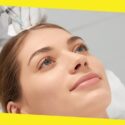Understanding Progressive Lenses

There are a wide variety of glasses for people to consider that encompass a range of styles and functionality. The most common type of glasses are single vision lenses which have the largest field of vision to correct vision at a specific distance. Bifocals are typically prescribed for people with a myriad of vision problems, like myopia (near-sightedness) or presbyopia (far-sightedness).
The disadvantage to both bifocals and trifocals is the distinct line between the field of vision in each that causes sections of the lens to produce a drastically different vision. This issue has led to the emergence of progressive lenses as a solution that many people requiring prescription eyewear are considering. It’s helpful to understand the lenses to figure out if they’re right for you.
What Are Progressive Lenses?
For those that need bifocals or trifocals, progressive glasses provide the same correction without lines between each section. They are preferred by many because of the smoother transition between fields of vision they provide. The overall field of vision for progressive lenses is much smaller, however, which is why many people revert back to bifocals or trifocals.
With progressive lenses, people can see at all distances with only one pair of glasses. They begin with the distance prescription at the top of the lens which increases as you move towards the bottom of the lens. Progressive lenses are regarded as many as three prescriptions in one as they offer optimized vision at close-up, middle-, and far-away ranges and are the most modernized versions of bifocal and trifocal lenses.
Do You Need Progressive Lenses?
As you age, the eyes often become weaker, with presbyopia commonly affecting many adults as they reach senior citizen age. Determining the best eyewear depends on overall eye health and prescription. Before an optician prescribes corrective lenses, you should have a comprehensive eye exam to test visual acuity and overall optical wellness. If you notice that your eyes take more time to adjust, you should check for any near-sightedness or far-sightedness issues.
If you have multiple prescriptions, you should get progressive lenses to correct possible far-sightedness, near-sightedness, or other conditions that compromise your vision. You should also opt for progressive lenses if you suffer from presbyopia, which essentially means the lenses in your eyes don’t move as easily as before, which can cause issues with your near vision. Progressive lenses are the best option for correcting vision without lines.
What are the Benefits of Having Progressive Lenses?
Aside from being essentially three prescriptions in one pair of glasses, progressive lenses allow you to be able to read books up close, casually read a website on a laptop, and even drive without needing to change your glasses as the conditions change. As multifocal lenses, progressive lenses are also more convenient, are a safer option in many instances, and are more comfortable than alternatives. With so many people reporting how easy it is to acclimate to progressive lenses, they are advised for those already accustomed to wearing prescription glasses and looking for a more natural feel.
Do You Need Glasses If You Wear Contacts?
Even if you wear contacts normally on a daily basis, you still should always have a pair of glasses on standby in case you need to relax your eyes and give them some moments to reset. With glasses, you won’t have to worry about lenses touching your eyes and robbing them of oxygen or possibly causing an infection. Everyone needs to allow their eyes a few hours each night to rest, but going for even a week or longer without contacts is also advisable.
For people that suffer from allergens in the air, a backup pair of glasses is a fast solution to achieve clear, comfortable vision. Another important factor to remember is that prescriptions are not the same for contacts and glasses, and there may be additional specifications and measurements taken to achieve the best fit. Be sure to find the ones that work for your needs.
Find the Best Fit For You
In the final analysis, all of your eye-fitting details should be based on the size and shape of your face, frame design, and whatever other personal additions you would like to make in your customization. As a long-term investment that you will be wearing daily, you should research a few styles and ask enough questions until you feel comfortable with the optician and the finished product. With an open line of communication between you and your eye doctor, it is possible to get the best progressive lenses that fit your preferences and lifestyle.
You may like this
Recommended For You
7 Common Reasons To Visit A Gastroenterologist: Bharat Pothuri, MD
Most Inside
Most Inside offers high-quality recommendations and valuable updates to enhance all aspects of your life, providing premium guidance and enriching experiences.




